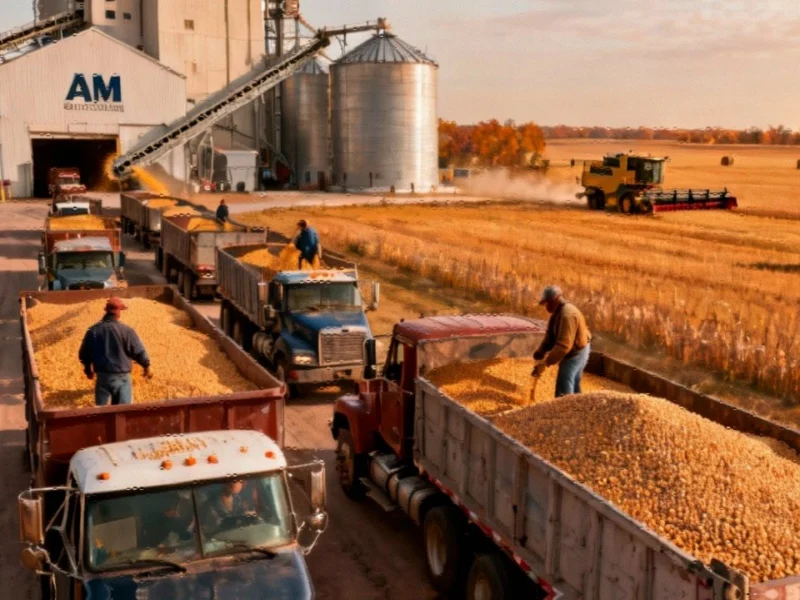Processor Implements Unusual Harvest Season Strategy
Archer-Daniels-Midland Co, one of the world’s largest grain merchants, is reportedly offering unusual incentives to U.S. farmers to deliver soybeans to its major processing facility in Decatur, Illinois, according to industry sources. The program, described as free deferred pricing, allows farmers to deliver crops immediately while setting the final sale price as late as September 2026 without paying storage fees, sources indicate.
The move comes during what should be the peak delivery period of autumn harvesting, suggesting significant supply challenges for major processors. Analysts suggest the unusual timing indicates ADM needs immediate soybean supplies to maintain processing operations despite the seasonal abundance typically available during harvest.
Farmer Resistance Creates Supply Pressure
According to the report, many farmers are choosing to store their soybeans rather than sell at current prices, creating supply constraints for commercial processors. Farmers and analysts suggest this resistance stems from combination of bumper harvests depressing prices and high input costs squeezing profitability.
“Because the prices are low, everybody is storing grain on the farm and saying: ‘No, you’re not getting my grain until prices go up,'” farmer Steve Pitstick told Reuters. This sentiment appears widespread, with some farmers reporting they had sold only 20% of expected crops heading into harvest, compared to their typical 50% pre-harvest sales.
Trade Tensions Reshape Global Markets
The situation reflects broader challenges in global grain trade patterns, particularly the impact of ongoing trade tensions between the United States and China. China, traditionally the largest importer of U.S. soybeans, has shifted significant purchasing to South America in response to tariffs, depriving American farmers of their primary export market.
This market disruption comes amid other significant tariff-related trade adjustments affecting multiple agricultural sectors. The changing dynamics have left farmers struggling to find profitable markets for their grain crops despite strong production.
Storage Economics Favor Farmer Holding
The deferred pricing offer addresses several practical challenges farmers face during harvest season. With limited on-farm storage capacity and costs for commercial storage running several cents per bushel monthly, the ADM program eliminates storage expenses while allowing farmers to maintain price exposure.
This approach to soybean marketing represents an unusual compromise between processor needs and farmer preferences. While ADM gains immediate access to crops for processing, farmers retain the potential benefit of future price improvements without incurring storage costs.
Broader Industry Context
The agricultural sector continues to navigate complex market conditions alongside other industry developments in food production and processing. Similar challenges are emerging across agricultural commodities as producers and processors adapt to changing global trade patterns and domestic market conditions.
These agricultural market shifts coincide with broader market trends affecting multiple sectors. The intersection of commodity production, global trade, and processing economics continues to create complex challenges for industry participants.
Financial Pressure Mounts for Farmers
According to the report, the financial situation for many farmers has become increasingly precarious. American Farm Bureau Federation President Zippy Duvall described “an alarming number of farmers are financially under water” in a recent letter to the Trump administration seeking support payments.
The Agriculture Department has indicated potential aid programs for soybean farmers once the recent government shutdown concludes. Meanwhile, processors have been raising their basis bids—the difference between futures and cash prices—to encourage more crop sales, analysts suggest.
Processing Demand Remains Strong
Despite the farmer resistance to selling at current prices, demand for soybean processing remains robust. National Oilseed Processors Association data showed September soybean crushings reached the fourth highest monthly level on record, indicating strong processor demand for available supplies.
This strong processing demand contrasts with other sectors experiencing different related innovations in production and distribution. The divergence highlights how specific commodity markets can experience unique supply-demand dynamics even within broader agricultural trends.
Regional Infrastructure Considerations
The concentration of processing capacity in locations like Decatur, Illinois—a major grain processing hub—creates additional logistical considerations for both farmers and processors. Regional infrastructure investments can significantly influence marketing decisions and supply chain efficiency.
Similar infrastructure considerations are emerging in other sectors, including recent technology and industrial development projects that require specialized facilities and zoning approvals.
Future Market Implications
The success or failure of ADM’s unusual pricing offer could influence how other processors approach similar supply challenges. If effective, the strategy might become more common during periods of significant price disagreement between farmers and buyers.
These agricultural market developments occur alongside other significant market trends in technology and infrastructure investment. The intersection of commodity production and advanced technology continues to evolve across multiple sectors.
This report is based on information from Reuters and reflects industry analysis of current agricultural market conditions. For complete licensing information, please review Reuters content licensing requirements.
This article aggregates information from publicly available sources. All trademarks and copyrights belong to their respective owners.



